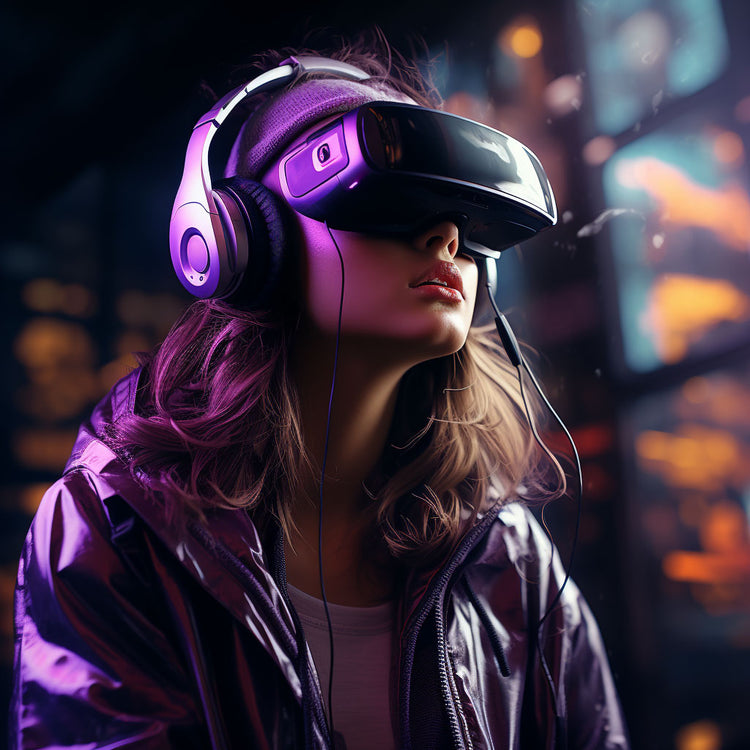Collection: AI-Powered Virtual Reality AR and VR Porn
With AI-Powered Virtual Reality AR, and VR Porn, you get to take your satisfaction to the next level. These tools promise enhanced engagement and realism while keeping the whole experience immersive and satisfactory. They have been designed with the latest technological advancements to turn virtual pleasures into life, while the focus is on augmented reality and virtual reality.

Top NSFW AI-Powered VR and AR Gear
-
Stripchat VR
Vendor:Stripchat.comRegular price $9.99Regular priceUnit price / per -
SexSelector
Vendor:Sexselector.comRegular price $1.00Regular priceUnit price / per -
LifeSelector
Vendor:Lifeselector.comRegular price $9.95Regular priceUnit price / per -
Virtual Taboo
Vendor:virtualtaboo.comRegular price $9.99Regular priceUnit price / per -
Virtual Sex World
Vendor:Virtualsex.worldRegular price $1.95Regular priceUnit price / per -
VRporn.com
Vendor:Vrporn.comRegular price $9.95Regular priceUnit price / per -
VirtualRealJapan
Vendor:Virtualrealjapan.comRegular price $0.43Regular priceUnit price / per -
TSvirtuallovers
Vendor:Tsvirtuallovers.comRegular price $9.99Regular priceUnit price / per -
SexLikeReal VR SLR
Vendor:Sexlikereal.comRegular price $14.99Regular priceUnit price / per -
Naughty America VR
Vendor:Naughtyamericavr.comRegular price $1.95Regular priceUnit price / per
Experience Reality, Redefined with AI-Powered VR and AR
-
Virtual Reality Experiences
With the best AI-Powered AI, AR, and VR Porn tools on the market, you engage in quite immersive virtual reality experiences. More specifically, these tools are compatible with almost every VR headset and let you explore your wildest desires in a new, captivating virtual reality environment. You can easily interact and communicate with digital characters and explore realistic sensations. Every encounter feels like a real deal, which ultimately translates to a greater engagement.
-
Adaptive Content and a High Degree of Personalization
It is not a secret that the best AI-Powered AI, AR, and VR Porn tools on the market promise the most engaging experience which is based on your specific needs and preferences. This high degree of personalization ensures that the digital content at your disposal is adjusted to your liking. The AI powering these tools tailor experiences based on your previous interactions and adjusts content to create more personalized digital partners and scenarios. This added to adaptive storytelling, which is the core of these tools.
-
Realistic Interactions with Virtual Characters
AI-Powered AI, AR, and VR Porn tools also promise rather realistic interactions with virtual characters of your imagination. The characters created based on your specific needs and preferences act and respond naturally and can easily interact with you and express their emotions. The characters are also crafted to adapt their communication skills and behavioral patterns based on your input, so the whole experience feels very realistic and lifelike.
Overview
The adult entertainment industry has been revolutionized with the use of artificial intelligence and other technologies, such as augmented reality and virtual reality. In fact, both AR and VR are at the forefront of the adult entertainment industry’s transformation. Both virtual reality and augmented reality, alongside artificial intelligence, promise more interactive and engaging experiences by making virtual reality seem like a reality.
With the use of artificial intelligence innovations, virtual reality and augmented reality offer users a greater level of personalization, engagement, and realism, making the whole experience unrivaled. AI-powered virtual reality is capable of creating lifelike virtual environments where you get to interact and engage with virtual partners. You also have the option to explore a variety of different scenarios and experience adult content in more unique ways.
Augmented reality technologies are another major factor in adult entertainment as they enhance real-world environments by incorporating different AI interactive elements and models. Regardless of which tool you choose, you enjoy a more customizable and personalized experience with interactions and virtual characters adapting to suit your desires and needs.
In fact, personalization is one of the major benefits of these tools. AI technologies employed by these tools rely on machine learning algorithms that do an amazing job of analyzing users’ previous interactions and their behavior. This means you enjoy more realistic character interactions and adaptive storytelling while having complete control over scenario customization. The AI technology mixed with AR and VR promises highly unique and personalized experiences that cannot be matched by any traditional tool of this kind.
How It Works
As you can imagine, AI-Powered AI, AR, and VR Porn tools are incredibly advanced. This is due to the fact that they combine the best of artificial intelligence technologies with augmented reality and virtual reality. The main goal is to offer the most immersive experiences that are highly realistic and go beyond what traditional adult content creation tools can offer.
At the core of these tools lies virtual reality technology that transports you to a digital environment where you meet and interact with AI-generated characters. To enjoy the experience, you need a standard VR headset, and you are good to go. With your headset, you step into a world of virtual characters that realistically communicate with you and have unique voices and facial expressions. The way virtual characters communicate with you is based on your previous interactions.
Equally important is augmented reality technology that combines real-world elements with those from the created digital world. More specifically, you can engage in virtual characters in your actual surroundings with your AR glasses, tablet, or smartphone. AR is responsible for blending fantasy and reality, making the whole experience feel way more personalized.
At the core of personalization lies artificial intelligence or, more specifically, machine learning algorithms that are responsible for creating a more interactive experience by adapting storylines and character responses to match your feedback, preferences, and behavior. Over time, the experience gets even better as machine learning algorithms use your feedback to adjust virtual characters and their responses to feel more realistic and natural.
Main Attractions and Features
Now, we get to the main attractions and features of the best AI-Powered AI, AR, and VR Porn tools that add to their appeal among audiences interested in exploring the world of adult entertainment.
- Engaging Virtual Environments: One of the major features of AI-Powered AI, AR, and VR Porn tools is the fact that they offer the user the ability to interact with virtual characters created to their liking in fully immersive virtual environments. This is possible thanks to the employment of virtual reality technologies and a simple VR headset.
- Fully Adaptive Interactions: The best tools of this kind on the market also promise fully adaptive interactions with virtual characters that feel very close to reality. Machine learning algorithms employed by the top-ranked tools learn from your past behaviors and interact to match your preferences and desires more accurately over time. This means that every encounter with a virtual character feels more engaging and unique than the previous one.
- Real-World Interaction with Virtual Characters: Thanks to the employment of augmented reality technologies, the best AI-Powered AI, AR, and VR Porn tools let you communicate and interact with virtual characters in your own surrounding. This basically means that the most advanced AR technology is responsible for removing the barrier between reality and fantasy.
Future Trends in AI-Powered AI, AR and VR Porn
With technological advancements of the future, the adult entertainment industry powered by artificial intelligence is set to become even more interactive, realistic, and engaging. In fact, innovations in haptic technology and machine learning will probably greatly impact the experiences with AI-Powered AI, AR, and VR Porn by promising a greater level of personalization and customization while offering more ways to engage in virtual characters.
In the future, we will more likely witness the introduction of hyper-realistic artificial intelligence companions that will exhibit more advanced interactive and conversational abilities. More specifically, virtual companions in the future will be able to engage in more dynamic and meaningful interactions and adapt their personalities and behaviors based on user input in real time.
Users will also be able to experience more pleasurable sensations with the introduction of advanced wearable technology led by innovations in haptic technology. Real-time customization with the use of artificial intelligence is the next logical step, which will enable users to modify character appearances and virtual environments in a matter of seconds.
Security and Privacy in AI-Powered AI, AR, and VR Porn
The top-ranked AI-Powered AI, AR, and VR Porn tools are safe to use as they rely on the most advanced data encryption technology. This technology safeguards user information and protects it from all sorts of possible cyber-attacks and threats. There is also a greater degree of anonymity these platforms offer, which basically means you can enjoy AI-powered adult content without revealing your real identity.
These platforms feature premium content which means you need to spend some bucks to enjoy it. With the employment of secure payment processing, these platforms ensure hassle-free and safe transactions regardless of which payment service you use. It is also not a secret that spending time on these platforms means you have complete control over the data you share. You can easily delete history, clear all of your stored preferences, and make adjustments to the default privacy settings.
FAQs
What are AI-Powered AI, AR, and VR Porn tools?
AI-powered AI, AR, and VR Porn tools rely on artificial intelligence, virtual reality, and augmented reality to create more immersive and dynamic virtual sexual experiences.
How AI-Powered AI, AR and VR Porn tools work?
AI-powered tools of this kind employ AI, VR, and AR to create virtual content that is entirely based on your preferences and needs. They create virtual characters that you can communicate and interact with and each interaction is rather realistic.
Is it safe to use AI-Powered AI, AR, and VR Porn tools?
Yes, using AI-Powered AI, AR, and VR Porn tools is safe to use since they employ encryption technology and give you entire control over the personal data you share.
Can I use these tools without a VR headset?
For the most immersive experience, you need a VR headset, but you can use these tools without one.
Are virtual characters created by AI-Powered AI, AR, and VR Porn tools realistic?Yes, virtual characters created by these tools are super realistic. They interact in a natural way, have different facial experiences, and respond to emotional cues, gestures, and commands.




































